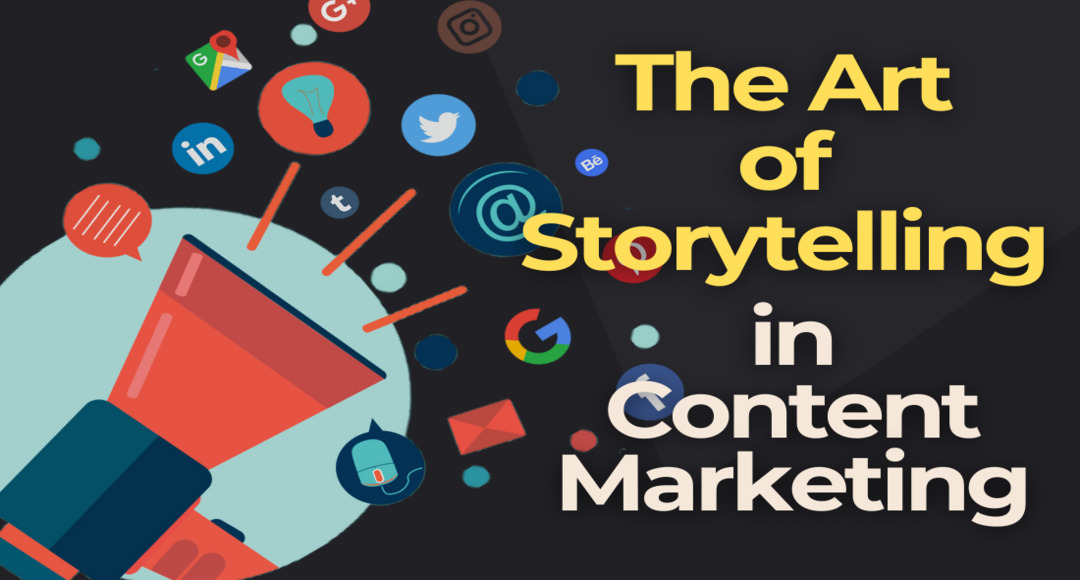The Art of Storytelling in Content Marketing
Content marketing has evolved significantly over the years, from straightforward product pitches to engaging narratives that resonate with audiences. At the heart of this evolution is storytelling. The art of storytelling in content marketing involves weaving compelling narratives that captivate your audience, foster emotional connections, and drive engagement. This blog will explore how storytelling enhances content marketing, the critical elements of a good story, and practical steps to integrate storytelling into your marketing strategy.
Why Storytelling Matters in Content Marketing
Storytelling is a powerful tool because it taps into a fundamental aspect of human nature. People are naturally drawn to stories. They help us make sense of the world, evoke emotions, and create lasting memories. In content marketing, storytelling can transform your brand message from a bland promotion into an engaging narrative that sticks with your audience.
Critical Benefits of Storytelling in Content Marketing:
Emotional Connection: Stories evoke emotions, making your content more relatable and memorable.
Engagement: Well-told stories capture attention and keep audiences engaged longer.
Differentiation: Unique stories help your brand stand out in a crowded market.
Trust and Credibility: Authentic stories build trust and credibility with your audience.
Persuasion: Stories are a powerful persuasion tool, influencing attitudes and behaviours.
Elements of a Good Story
A good story in content marketing should have the following key elements:
1. Characters
Characters are central to any story. They are the individuals your audience will connect with. In content marketing, your characters could be your customers, employees, or the brand.
Example: A clothing brand might tell the story of a customer who used their products to feel more confident and stylish.
How to Create Relatable Characters:
Understand Your Audience: Know your audience and what they care about.
Build Personas: Develop detailed character personas based on your audience’s insights.
Show Growth: Characters should grow and change throughout the story, mirroring the journey you want your customers to experience.
2. Conflict
Conflict is what makes a story interesting. It introduces challenges and obstacles that the characters must overcome. In marketing, conflict can be a problem your product or service solves.
Example: A software company might describe the frustration of managing projects manually before introducing its streamlined project management tool.
How to Create Compelling Conflict:
Identify Pain Points: Understand the problems and challenges your audience faces.
Make It Relatable: Ensure the conflict resonates with your audience’s experiences.
Highlight the Stakes: Emphasize the consequences of not overcoming the conflict.
3. Resolution
The resolution is part of the story where the conflict is resolved. It shows how the characters overcome their challenges, often with the help of your product or service.
Example: The same software company might show how their tool transformed project management, making it more efficient and less stressful.
How to Craft a Satisfying Resolution:
Be Clear: Clearly show how the conflict is resolved.
Provide Evidence: Support the resolution by using testimonials, case studies, or data.
Inspire Action: Encourage your audience to take the next step, whether purchasing or contacting you for more information.
4. Emotion
Emotion is what makes a story memorable and impactful. It helps create a deeper connection with your audience.
Example: A non-profit organization might tell a heartwarming story of how a donation changed someone’s life.
How to Evoke Emotion:
Be Authentic: Genuine stories resonate more than contrived ones.
Use Descriptive Language: Paint vivid pictures with your words to evoke emotions.
Show, Don’t Tell: Use real examples, testimonials, and visuals to convey emotions.
5. Message
Every story should have a clear message or moral. This is the takeaway that you want your audience to remember.
Example: A health food brand might tell a story that reinforces the message of healthy living and the benefits of its products.
How to Deliver a Clear Message:
Stay Focused: Keep your message simple and focused on one main idea.
Reiterate Key Points: Reinforce the message throughout the story.
Align with Brand Values: Ensure the message aligns with your core values and mission.
Integrating Storytelling into Your Content Marketing Strategy
To effectively incorporate storytelling into your content marketing strategy, follow these practical steps:
1. Know Your Audience
Understanding your audience is the foundation of compelling storytelling. Conduct market research, create buyer personas, and gather insights into their needs, preferences, and pain points.
Example: If your audience is young professionals, focus on stories highlighting career growth and work-life balance.
2. Define Your Brand Story
Your brand story is the overarching narrative that encapsulates who you are, what you do, and why you do it. It should reflect your mission, values, and the unique value you offer.
Example: TOMS Shoes tells a compelling brand story with its “One for One” mission, where every purchase helps someone in need.
3. Create a Content Calendar
Plan your storytelling efforts with a content calendar. Outline the types of stories you want to tell, the channels you’ll use, and the timeline for each piece of content.
Example: Plan blog posts, social media updates, and videos around a central theme, such as customer success stories or behind-the-scenes looks at your company.
4. Use a Variety of Formats
Storytelling isn’t limited to written content. Use various formats to reach your audience on different platforms and other ways.
Example: Combine blog posts, videos, infographics, podcasts, and social media stories to create a diverse and engaging content mix.
5. Leverage User-Generated Content
User-generated content (UGC) can be a powerful storytelling tool. Encourage your customers to share their experiences with your brand and highlight their stories in your marketing.
Example: A fitness brand might feature customer transformation stories on its website and social media channels.
6. Measure and Optimize
Track the performance of your storytelling efforts using key metrics such as engagement, shares, and conversions. Use this data to refine your approach and improve your future storytelling initiatives.
Example: Use analytics tools to measure how well your stories resonate with your audience and adjust based on your learning.
Examples of Effective Storytelling in Content Marketing
To see storytelling in action, let’s look at some brands that excel at using stories to engage their audience.
1. Nike
Nike’s marketing often features stories of athletes overcoming adversity. These inspirational narratives align with Nike’s brand message of perseverance and excellence.
Example: The “Dream Crazy” campaign, featuring Colin Kaepernick, told powerful stories of athletes who defied the odds, reinforcing Nike’s commitment to inspiring every athlete.
2. Airbnb
Airbnb uses storytelling to highlight unique travel experiences and the sense of belonging its platform offers. It shares stories from hosts and guests, showcasing diverse and authentic experiences.
Example: The “Made Possible by Hosts” campaign features real stories of Airbnb hosts and how they create meaningful travel experiences for guests.
3. Coca-Cola
Coca-Cola has long been a master of storytelling, focusing on themes of happiness, friendship, and sharing. Their campaigns often feature heartwarming stories that evoke strong emotions.
Example: The “Share a Coke” campaign encouraged people to share personalized Coke bottles with friends and family, creating a sense of connection and joy.
Conclusion
The art of storytelling in content marketing is about more than just sharing information; it’s about creating narratives that resonate with your audience emotionally. Incorporating characters, conflict, resolution, emotion, and a clear message into your stories can make your content more engaging and memorable. Understanding your audience, defining your brand story, and using a variety of formats will help you effectively integrate storytelling into your content marketing strategy. Brands like Nike, Airbnb, and Coca-Cola demonstrate the power of storytelling to build connections, foster loyalty, and drive engagement. Following their lead and focusing on authentic, compelling narratives can enhance your content marketing efforts and create lasting impressions with your audience.

